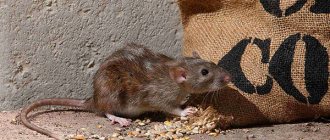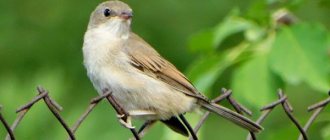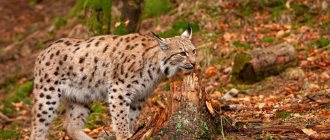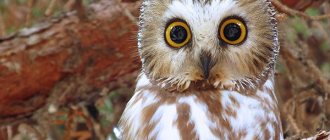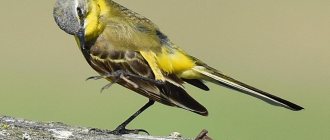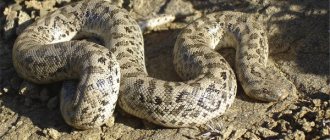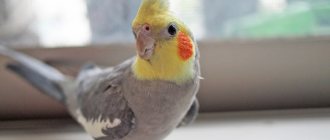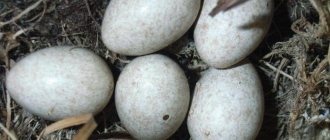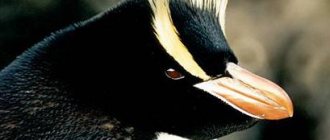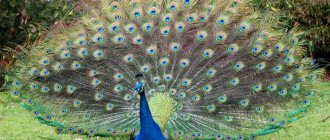The Dragon Li cat breed has many names in Chinese sources, but is more often referred to as Li Hua or Li Mao. These felines became especially popular in 2003, when they were first presented at an international exhibition. After that, they gained popularity in the USA, but in Russia they never took root (due to their similarity with ordinary “yard” cats).
Due to its striped appearance, the Li Dragon is the "image of the tiger" to the Chinese - symbolizing fearlessness, ferocity and military prowess. It is also believed that his image drives away evil spirits. In this connection, cats of this breed are a talisman and a talisman of housing for the Chinese.
All representatives of Dragon Li are strong and muscular animals of medium size. The weight of males can reach 5 kilograms, and females up to 3.5 kilograms.
The appearance standard of the Dragon Li breed can be described by the following characteristics:
- The head is elongated towards the nose, with a rounded occipital part. The corners of the mouth are highlighted in black, which creates the impression of a “smile.” Be sure to have a dark tip of the nose - this is one of the distinguishing characteristics of the breed. The eyes are set slightly obliquely (the outer corner is always lower than the inner) and almond-shaped. Mostly presented in yellow or green shades (they stand out brightly against the background of the color of the coat).
- The ears are large but proportional. At the base they are quite wide with a rounded top.
According to the standards, individuals with the following characteristics are rejected:
- long wool;
- malocclusion;
- large ears;
- nose without darkening;
- extra fingers;
- there is no characteristic “necklace” on the chest;
- overweight;
- non-standard eye shade;
- fuzzy fur pattern;
- lack of slanting.
All of the above can serve as evidence of the absence of a breed or mixing with other species.
History of the breed
The time of appearance of this breed is unknown, but archaeologists have found the remains of cats that lived more than 3,000 years ago. Images and references to them are found in ancient manuscripts of the 6th-10th centuries dating back to the Tang dynasty. Then, for the first time, it was allowed to keep these animals not only in the imperial family, but also among minor officials. The cats quickly multiplied and became popular.
In China, the eponymous Li Dragon is considered a natural, self-domesticated breed as a subspecies of the wild Chinese mountain cat (Felis silvestris bieti). Although this theory is still somewhat controversial, it has also not been scientifically disproven, and is therefore widely accepted as the origin of this variety in established breeding sources in China.
All other cat breeds in the world are known to be descended from F. s. lybica, the steppe cat (sometimes called the African wild cat, which is not entirely correct).
The Chinese interpretation of the symbols is based on a legendary description rather than a completely accurate modern depiction of the breed's letter designation, resulting in the cat being confused with a wild fox. For this reason, the literally translated characters for Li Hua Mao are read as 貍 from 狐貍 ("fox"). 花 means "flower", indicating flower-like color patterns, and 貓 translates to "cat".
This Chinese character description, considered the best interpretation before modern Western cat terminology became standard, described the tabby as a "flower pattern."
Now Li Hua is classified as an endangered species and is listed in the International Red Book. There are about 10 thousand individuals all over the world. The sharp decline in numbers is associated with the use of poisons to control the rodents that these felines feed on. Their high price on the market attracts the attention of poachers, which also does not lead to an increase in their number.
Today they are bred artificially, but not all types of Chinese cats have been tamed. For example, mountain Huang mo mao are very freedom-loving, so they are practically never found at home.
Global standards for Li Huang were developed in 2005, and it received international recognition in 2010, when official international registration was carried out.
There is no market or fashion for domestic cats in China, which is why there are no many breeds.
Exist:
- Li Hua, which is cultivated by natural selection,
- Chinese white;
- The Gobi gray cat lives in nature reserves or zoo corners; its wild character does not allow it to become docile and affectionate.
Sometimes they talk about the fold, but it belongs to extinct animals, because... it has been impossible to find representatives since 1920.
Munchkin
This breed differs from others in that its representatives have short legs. As a rule, they are two to three times smaller. That is why this breed is colloquially called the dachshund. Cats received this distinctive feature through the process of mutation, which sometimes happens to domestic animals. This is their main difference. Other external features of individuals of this breed have not changed. The spine and its flexibility remained the same.
Munchkins are intelligent cats, they are pleasant to talk to and easy to care for. There are representatives with both long and short hair. There are cats of various colors and combinations, and you can also see a medallion.
This breed is unique not only with its paws. Cats with short legs have a round head and specially shaped eyes, a long or short nose, and a protruding chest.
Munchkins are very popular among people. They are especially adored by children. A good friend and loyal comrade - what could be better?
Mr. Cat Recommends: Li Hua's Advantages and Disadvantages
Each breed has its pros and cons. This also applies to the Chinese cat. Here are some of its advantages:
- distinguished by devotion to its owner;
- has an exotic origin;
- has a light character, which allows him to live in harmony with other animals;
- there is no aggressiveness;
- does not require special attention;
- gets sick very rarely;
- characterized by intelligence and intelligence.
Negative parameters include the following:
- Difficulty in purchasing and selecting a partner for mating: a purebred breed can be found in China or the USA.
- High cost: a kitten is quite difficult to find.
- Normal development: requires a spacious room to allow for activity and movement.
- Attitude towards children: tolerant, but not for long, so it is better to avoid such contacts.
- Difference: Can be confused with other breeds.
Ecology[edit | edit code]
Several reliable observations indicate that the main habitats of the Chinese cat lie in mountainous areas from 2800 m to 4100 m above sea level; these are alpine meadows, thickets of bushes, forest edges and hilly steppe areas. Not found in real deserts. These cats live in areas with some of the most extreme climates in the world, characterized by very high summer and low winter temperatures, with strong wet or dry winds blowing throughout the year.
Enemiesedit | edit code
The main threat to this species is human activity. These animals are also subject to hunting.
In China, starting in 1958, a large rodent extermination campaign was carried out with the following goals: to reduce the population of zokor and other rodents, which were considered as important competitors to local livestock. Rodents are the main prey of the Chinese cat, so the reduction in their numbers has had a negative impact on the animal's population. Also, cats and other predators died from poisoning, mainly zinc phosphide. Its use was discontinued in 1978 because the poison was found to kill all carnivores that preyed on rodents.
Foodedit | edit code
The Chinese cat feeds on small mammals, mainly rodents: rats, moles, zokor, as well as rabbits, insects, reptiles and birds, including pheasants.
Characteristics and breed standard
Outwardly, Li Hua is very similar to an ordinary yard cat, so it is quite difficult for a person who does not understand the breeds to distinguish between them. Description of characteristic distinctive features:
- Body type: dense, strong, compact and graceful. Large chest and straight back.
- Dimensions: medium to large. Length is about 90 cm, of which the third part is the tail.
- Weight: male - 5 kg, female - 3.5.
- Paws: powerful, large, oval. The fore and hind limbs are the same size. Black or dark grey.
- Tail: long. Wide at the beginning and narrowed at the end. Covered with uniform dark rings.
- Head: elongated with a round forehead.
- Muzzle: longish, pointed. The flat chin is well developed. Heavy lower jaw.
- Cheeks: convex.
- Eyes: large, slightly cross-eyed. Green (less valued) or yellow. Outlined in black.
- Ears: Tips rounded with tassels. Slightly tilted forward.
- Mouth: black dots at the corners create a smile effect.
- Nose: Width the same as the size of the eyes. Dark brown or black without light spots.
- Coat: short, silky, soft, small undercoat. Males are tougher.
- Ticked color: brown or chocolate tabby. Gives off a glossy shine. The hair is dark at the base, light in the middle, and chocolate at the end. The drawing is clear and bright. In winter it is more yellow, in summer it is darker.
- Black color: spots on the belly, stripes extending from the eyes and cheeks, tip of the tail, M-shaped pattern on the head, necklace on the chest.
- Development: mature by 3 years. A kitten can be transported after the age of 3-4 months.
- Appearance: Resembles a lynx.
External signs
At first glance, Dragon Li is no different from a mongrel domestic cat and an ignorant person cannot distinguish them. But of course, differences exist. Li Mao is a large, muscular cat with strong, strong legs and an even posture. Unlike most breeds, Li Hua's hind legs are the same length as her front legs. The tail is proportional to the length of the body and is quite thick.
The shape of the head is slightly elongated and has a graceful round forehead. The cat's face is round with an even profile and a massive chin. The eyes are the highlight of this breed. They have an almond shape and a slightly slanted fit. Eye color can be yellow or green.
Li Hua's coat is two-layered, thick and densely packed, but has practically no undercoat. Males' coats are usually rougher to the touch than cats'. The only color recognized as a standard is brown tabby. Black stripes should be on the head and throughout the body, the tail is covered with black rings, the tip is completely colored. Each individual hair of fur is colored in three shades: black, brown and light brown.
Features of temperament
When purchasing a cat, you should always know its characteristics. Li Hua will wait for the owner to take the first step when making an acquaintance, and only after showing friendliness on his part will he make contact. It is characterized by autonomy and independence.
He is distinguished by his devotion, but does not sit in his arms for a long time and does not get bored alone. Long-term lack of attention from the owner is hard to bear. Doesn't like small spaces; she needs room to move. She is very curious, but not trusting, so she will look at guests from afar.
An excellent hunter - gets rid of small animals, rodents and birds. If he feels forced, he will defend himself and use his teeth and claws - it is better to keep children away from him. Thanks to his innate intelligence, he can be taught to carry out simple commands. Does not tolerate change of environment well.
Is it possible to keep an animal at home?
The animal is nocturnal and camouflages itself very well, so it is almost impossible to study its habits in the wild. All descriptions are based on observations of zoo inhabitants. Males and females live separately; they spend most of the day in burrows that they create themselves. Females have deeper and more protected burrows. The living space of one individual is 12–15 square meters. km.
Wild cats have received protected status, so they can only be kept in zoos. However, some wealthy people buy animals from smugglers and try to make them into pets. Once in the presence of a person, a mountain cat usually finds a reliable shelter and spends most of its time there. During the mating season, she can become very aggressive.
In nature reserves and zoos, mountain predators always strive for solitude; they do their best to avoid contact with humans and other inhabitants of the territory. Animals in nature occupy vast spaces, so in captivity they also need space.
To keep animals of this breed at home, you will need a large enclosure where the predator will have a place to rest and a secluded nest among tree branches. In a house or apartment, wild individuals will instinctively look for a place hidden from human eyes, dig holes and build nests.
The habits of wild ancestors remain with predators that were taken into the home at an early age. It is impossible to train them to a tray and prohibit them from making night forays for the purpose of hunting. The pet will regularly mark the territory, sharpen its claws and create inconvenience for its owners at night.
In nature, animals constantly practice jumping and climbing trees. At home and when kept in an enclosure, they need to build shelves, stands, and slides so that the cats can maintain physical fitness and remain healthy.
In addition, wild pets that live at home require timely vaccination. The first vaccinations are given at the age of 8–12 months. Then the Chinese breed animals are vaccinated annually. It is quite difficult to treat wild predators, since they have poor contact with people. Trying to help an animal can result in injury for the veterinarian.
Regular food from the home table is not suitable for these predators. In nature, they eat only natural food, so at home they constantly need fresh natural meat. If there is not enough meat in the diet, the pet may develop diseases of the musculoskeletal system. The cat needs to get rodents and birds every day. To keep her healthy, the owner will have to take care of this.
Care and maintenance
For normal development of a Chinese cat, a private home is best suited. You can equip a spacious enclosure for her, in which it is necessary to provide places: for resting, feeding, scratching posts, for activity - trees or structures. The enclosed small space of the apartment will not suit her.
Maintenance is easy:
- Wool: requires attention. She is combed 1-2 times a week. Every day - during the molting period.
- Bathing: done rarely - once every six months.
- Cold weather and drafts: they are poorly tolerated, so in winter they use special clothes, and after washing they dry them with a hairdryer.
- Nails: trim very carefully. This procedure is necessary for those cats that are constantly in the house.
- Eyes and ears: rinse with warm water or special products.
- Tray: with high sides. Must be kept clean.
- Veterinarian: Show regularly. Carry out preventive vaccinations.
Low maintenance requirements allow them to be maintained by busy people.
Description of the species
The species has still been practically not studied in natural conditions - even descriptions of the appearance and habits of animals were compiled mainly in zoos.
The secretive Chinese cat can only be seen properly in a zoo
External data
Externally, the Chinese mountain cat is so similar to the European wild cat that it can be mistaken for an enlarged copy of the European cat, but in fact they are completely different species. The “Chinese” has a strong, stocky body and short, strong legs, with which it digs out rodent burrows in search of prey. The muzzle is wide and rounded, large ears are crowned with long tassels. The thick fluffy tail is decorated at the base with several dark rings.
The striped coat of the mountain cat changes its color according to the seasons - in winter the animal's color becomes darker. The fur is dense and rather long, with a well-developed undercoat - grayish-brown on the back and sides and much lighter on the belly. The fur grows abundantly even between the paw pads - this is a unique property of the Chinese mountain cat and is not found in any other species of wild cats.
Chinese mountain cats and European wild cats look like twins
Video: features of the Chinese mountain cat
Lifestyle and nutrition
Like many wild cats, representatives of this species go hunting mainly at night and are very active at dusk, and during daylight hours they sleep in burrows, hollows and rock crevices
Predators are very secretive and cautious; they pay great attention to the safety of their home. Females are especially successful in this - after all, their shelters also become “children’s rooms” during the period of raising offspring
The burrows of females are branched, zoned labyrinths with several well-camouflaged exits, while the burrows of males are much simpler and, as a rule, have only one exit.
Chinese cat goes hunting at dusk
This cat prefers to walk on her own
These animals prefer solitude and never gather in packs, except for the breeding season; they vigilantly guard the boundaries of their hunting areas, the territory of which usually does not exceed fifteen kilometers.
Reproduction
The mating season lasts from January to March - during this time, females and males unite in pairs; according to some assumptions, a female can mate with several males. After two to two and a half months, kittens are born; there are usually no more than four of them in a litter. The female is responsible for feeding and raising the offspring independently. She arranges her home in advance to create a nest for her cubs.
Chinese mountain cats are caring mothers
What to feed
The diet depends on the age, sex and health of the individual. Li Hua have an excellent appetite, but they are not overweight.
They are usually fed warm food in the morning and evening. You can use ready-made premium, super premium or holistic food or natural products. Mixed food is allowed, but it is imperative to serve them at separate times: artificial and natural food.
Meat, vegetables and cereals are boiled before serving. Fruits, fatty and sweet foods are not included in the diet. Dairy products - only low-fat and not very often. Fish and chicken bones are not given. Constant access to drinking water must be provided.
Cat food Dragon Lee
Experts advise feeding adult cats and female cats twice a day at the same time, calculating the portion based on the weight of the animal. For 1 kg of weight you need 40 grams of natural food or 20 grams of balanced food.
It is necessary to adhere to a balanced diet that includes all food groups. The fish must first be boiled, and it is preferable to give lean meat. Also sometimes needed: fermented milk products, cereals and vegetables.
Cat food Dragon Lee
It is worth choosing low-fat varieties of meat. The fish must be boiled first. Don't forget about vegetables, cereals and fermented milk products.
Since simple food does not have the full range of vitamins and minerals that cats need, give these complexes additionally. It is forbidden to feed cats from the owners' table: sweet, salty, spicy, fried foods and any seasonings are contraindicated for them.
Health
The Chinese cat breed was formed naturally, so it has excellent health and immunity. She has no genetic or hereditary pathologies, but problems may arise with age.
There are the following: hair loss, gastrointestinal diseases, with improper feeding - obesity, inflammation in cats after castration. Causes of disease: lack of vitamins, minerals, sedentary lifestyle. With proper care, they reach the age of 14-15 years.
Interesting Facts
Interesting information about the breed will help you get to know the dragon better:
- These animals are distinguished by their independent character, but show exceptional devotion to their owner.
- Chinese cats are smart and can be trained. One famous person from China trained his pets to bring him newspapers.
- In China, these animals are sometimes taken to wedding ceremonies.
- Chinese cats grow very slowly, so breeders do not give away kittens at an early age, but wait until they are stronger.
- The Chinese believe that li hua can protect the home from evil spirits.
How much does it cost and how to choose a kitten
It is quite difficult to buy a representative of this species, because... nurseries are located mainly in China. You not only need to purchase a kitten, but also pay for its transportation. Their cost is high - from $500 and above. If they offer to buy a cat at a low price, then it cannot be a representative of this rare breed.
When choosing, be sure to pay attention to the presence of:
- breed standards;
- pedigree;
- list of vaccinations given;
- healthy appearance;
- natural activity.
The kitten should not have any physical disabilities and be 3-4 months old or older.
1111
Character
The Dragon Li is an affectionate and calm breed. Although these cats cannot be called independent, they are still less affectionate towards people than most breeds. Nevertheless, they easily make contact, are sociable and playful. Li Mao get along well with other animals in the house and do not show aggression. But cats of this breed do not get along well with children. They do not show aggression towards them, but they are not in a hurry to make friends, preferring to stay at a distance from them.
This breed is well suited for keeping in an apartment. Li Hua are moderately active, but quite calm. They do not refuse to play, but when they are at home on their own, they prefer to sleep peacefully in a secluded place.
Where does the jungle cat live?
Photo: Jungle cat in nature
Jungle cats love warm climates, which is why their favorite places of residence are Central Asia and the Caspian coast. They also live near the rivers of Africa (Nile), in Thailand, on the island of Sri Lanka, in Palestine, India, Indochina, in eastern Eurasia, and in the Caucasus. On the territory of the Russian Federation, in addition to the Caspian Sea, they can be found in Dagestan and in the lower reaches of the Volga River.
Cats hate open areas, so they go there in rare cases, without going far from their place of permanent deployment. Cats love bushes and reeds, where they feel most at ease and safe. Seals love to settle in coastal shrub and reed areas. Houses are not at all keen on building their homes, but prefer to settle in empty fox and badger holes. They do not live in them for a long time, constantly moving to new places for safety reasons. You can see cat tracks on the shore; jungle cats leave them on the shallows. They swim and dive beautifully, hunting both aquatic birds and fish.
If a cat lives in a mountainous area, then it does not like to climb higher than 800 - 1000 meters, preferring its bushy, often thorny wilds. The cat doesn’t particularly want to have contact with people, leading a secretive and cautious lifestyle. During winter cold and early spring, it can visit human villages, carrying out bandit raids, with the aim of stealing poultry, which it loves to feast on.
Signs associated with tabby cats
Cats are considered protectors of home and people. They are able to cure mental wounds and physical illnesses. Pets are sensitive to all kinds of disasters, so they can warn of a flood, earthquake, fire or other troubles.
As for tabby cats, even in ancient times people noted their magical abilities. It is believed that such pets bring good luck and improve well-being:
If a tabby cat crosses a person’s path on the street, then you can expect pleasant turns in life. Red tabby cats are children of the Sun. They personify his energy and create harmony around them. With red stripes, warmth and comfort come into the house, and people live in abundance. Red pets are sometimes considered brownies. These animals get used not only to the owner, but also to the home, so they have a hard time with moving. According to signs, if a tabby kitten is found on the street asking for help, it should never be refused. By abandoning the poor fellow on the street, a person loses his wealth and good luck. If the cat left the house because of resentment, the person is in danger of trouble. You should find your favorite as quickly as possible and correct the situation with goodies. This will help prevent a series of troubles. If a person is lonely and unlucky, he is recommended to pick up a tiger kitten on the street. This must be done from the heart, otherwise luck will never come, and the cat will run away. Cats feel selfish people and never approach them, but they treat kind people well, try to protect them and save them from misfortune. Dreams in which the main character is a tabby cat are prophetic
It is important to be able to interpret them correctly. For example, if a dog is chasing a kitten, this is a warning to a person that deceiving friends may result in a quarrel. If a cat managed to jump onto a tree, and an angry dog is waiting for him below, this is a sign warning of danger emanating from loved ones. If the cat washes itself, this is a signal about the imminent arrival of guests. In this case, the pet does not necessarily have to be a dream. If a cat washes against the grain, this portends a change in atmospheric pressure and possible precipitation.
In this case, the pet does not necessarily have to be a dream. If a cat washes against the grain, this portends a change in atmospheric pressure and possible precipitation.
Regardless of color and magical abilities, any cat is a living being and needs love, affection and care.
